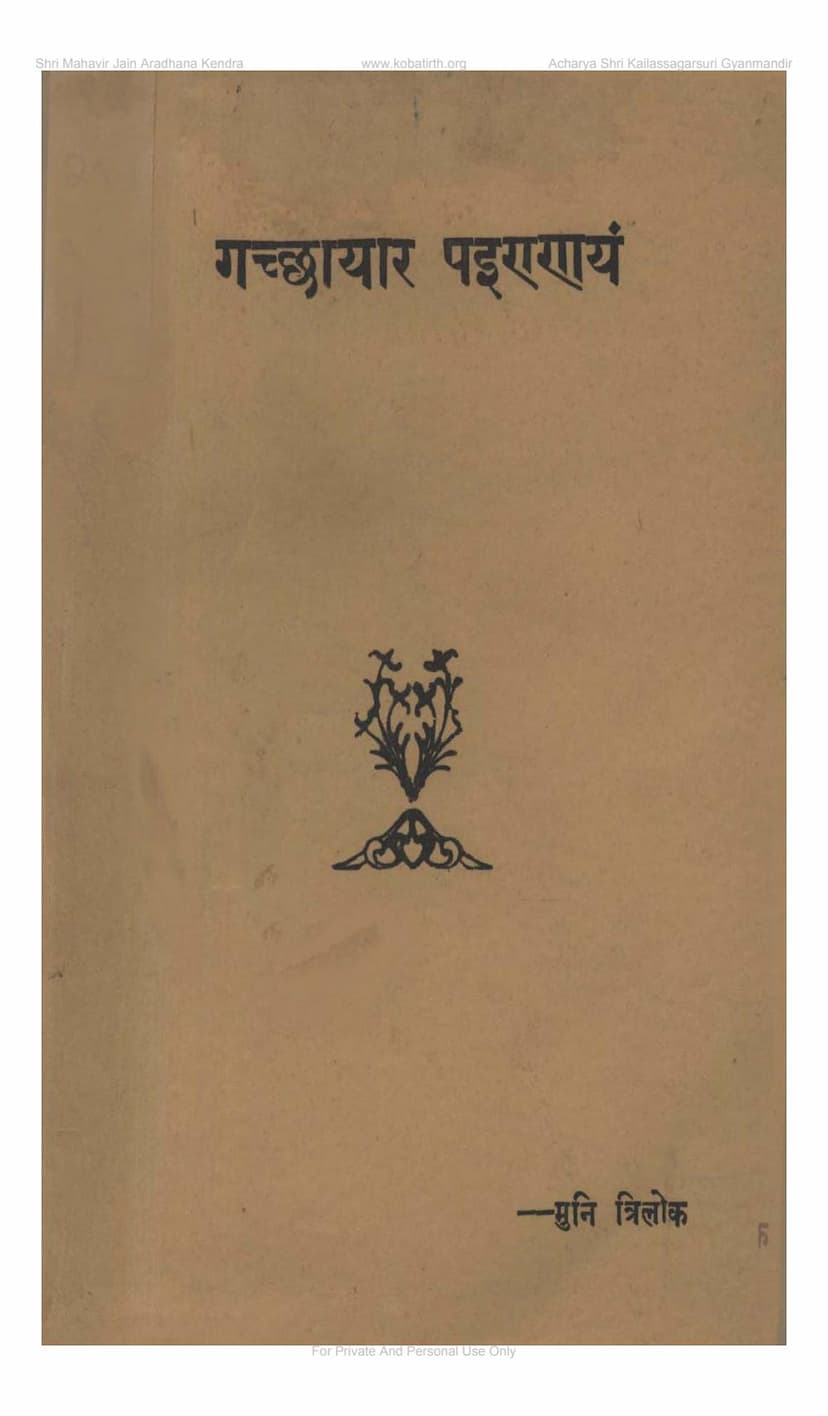Gacchayar Painnayam
Added to library: September 1, 2025

Summary
This document is a summary and partial translation of the Jain text "Gacchayar Painnayam" (गच्छाचार पइएणय), authored by Muni Trilok. It focuses on the conduct and principles of the Jain monastic community, particularly regarding the role of the Acharya (spiritual leader) and the characteristics of a true Gachha (monastic order).
Here's a breakdown of the key themes and content:
Introduction and Dedication:
- The book is dedicated to Lord Mahavir.
- It is presented as a collection of pearls extracted from the ocean of scripture, pertaining to the conduct of the Gachha.
- The publisher is Ramjidas Kishorchand Jain.
Core Concepts and Themes:
-
The Importance of a Righteous Gachha:
- The text emphasizes the danger of staying in an "unmarga" (wrong path) Gachha, warning that it leads to cyclical rebirths.
- Conversely, adhering to a "sam-marga" (right path) Gachha is crucial for liberation from suffering and the cycle of birth and death.
-
The Role and Qualities of an Acharya (Spiritual Leader):
- The Acharya is the central pillar and foundation of the Gachha, guiding and supporting its members.
- The text outlines crucial qualities of a good Acharya:
- Knowledgeable and Ethical: Proficient in scriptures and adhering to moral conduct.
- Disciplined: Practicing self-control and adhering to monastic rules (Samayachara).
- Humble and Pure: Open to confession and purification, even if possessing virtues.
- Responsible: Caring for the disciples, guiding them on the right path, and not being indulgent.
- Courageous and Principled: Upholding Jain principles even in difficult situations.
- Exemplary: Living a life that inspires others.
- Signs of a Corrupt Acharya (Unmarga Acharya):
- Acting according to whims (swachhandachari).
- Engaging in worldly activities and violence (arambha).
- Being attached to comfort (peethyaadi).
- Violating monastic vows and rules.
- Engaging in gossip and frivolous talk.
- Lacking discipline and self-control.
- Ignoring the misconduct of disciples.
- The text stresses that the quality of the Gachha largely depends on the quality of its Acharya.
-
Qualities of a True Gachha and its Members (Sadhus):
- A true Gachha is characterized by its members who are "gitartha" (those who understand the meaning of scriptures).
- Members should be diligent, free from laziness, firm in their vows, and free from attachment and aversion.
- They should possess qualities like forgiveness, self-control, detachment, and adherence to the ten types of Samayachara.
- The text emphasizes the importance of right association and warns against associating with those who are ignorant or of corrupt character.
- Specific Conduct Guidelines:
- Disciple-Guru Relationship: Disciples should respect and heed their Gurus. A Guru has the responsibility to guide and correct disciples.
- Interactions with Nuns (Aryakas): Strict boundaries and avoidance of unnecessary contact are advised. Nuns should not be involved in worldly affairs or excessive grooming.
- Food and Possessions: Strict adherence to rules regarding food collection, acceptance, and avoidance of worldly possessions (gold, silver, comfortable beds, colorful clothes).
- Conduct During Difficult Times: Upholding Jain principles even during famines or personal hardship.
- Discipline and Excommunication: The Gachha has the authority to expel members who violate core principles (mulagunas).
- Importance of Righteous Conduct: The text emphasizes that actions like harmful speech, attachment to the body, and engagement in frivolous activities are detrimental to spiritual progress.
- The Role of the Acharya in Maintaining Order: The Acharya must ensure that rules are followed, and misconduct is addressed.
-
The Essence of Jain Practice:
- The core of Jain practice lies in Knowledge (Gyana), Faith (Darshana), and Conduct (Charitra).
- The ultimate goal is liberation (Moksha).
- The text highlights the importance of self-effort and following the path prescribed by the Tirthankaras.
Structure of the Text: The text appears to be divided into sections:
- Acharya Swarup Nirupan (Description of the Acharya): Discusses the qualities, responsibilities, and signs of a good and bad Acharya.
- Sadhu Swarup Nirupan (Description of the Sadhu): Outlines the conduct, behavior, and principles that a Sadhu should follow.
- Sadhvi Swarup Nirupan (Description of the Sadhvi): Details the proper conduct and boundaries for Nuns.
- Conclusion (Upasamhar): Summarizes the essence of the text and encourages adherence to its teachings.
Overall Message: "Gacchayar Painnayam" serves as a comprehensive guide for Jain ascetics, outlining the ideal conduct and principles necessary for maintaining the purity and integrity of the monastic order (Gachha). It emphasizes the paramount importance of adherence to scriptures, the guidance of a virtuous Acharya, and the individual and collective discipline required for spiritual progress and eventual liberation. The text provides practical guidance on a wide range of issues, from the spiritual qualities of leaders to the daily conduct of monks and nuns, all within the framework of Jain philosophy.